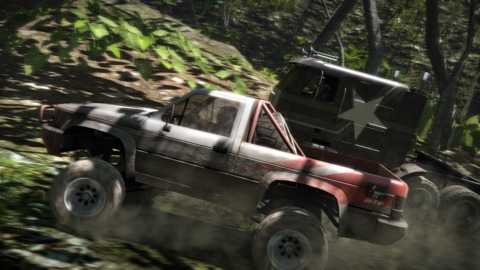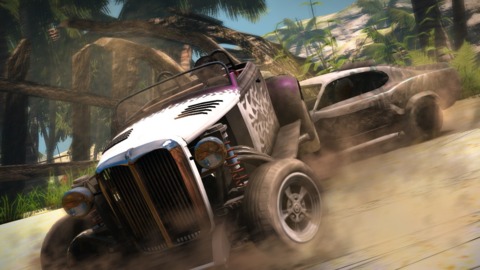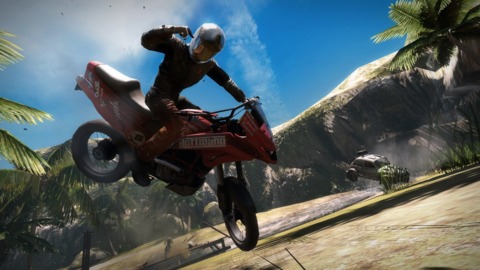
Maintaining the same Burning Man/Mad Max/Burning Max posture as its predecessor, Pacific Rift moves the action out of the desert and onto a fictional uninhabited island in the Pacific, which serves as a microcosm for a number of different, lushly detailed natural environments. You'll rip through the underbrush in dense jungles, splash across white-sand beaches, skitter around lava floes, navigate the rusted-over remains of an abandoned WWII military base, and more. One of Pacific Rift's biggest strengths is how wide-open and organic the tracks feel. Rather than feeling like you're going through race tracks that have been skinned to look like rare exotic locales, you get the sense that some people showed up and decided that the shale-covered cliffs surrounding this active volcano would be a great place to stage a race.
This willful inconsistency does wonders for the game's authenticity, and lends the game a certain danger-of-the-unknown, but its real impact is on how Pacific Rift plays. Like the original MotorStorm, races more often than not feature a number of different classes of vehicles competing at once. Ranging from motorcycles to big rigs, there's a good variety to how the different classes handle, though they all have a certain slippery quality to them. The tracks themselves play off this diversity with constantly diverging paths that are better suited for one class or another. You'll find narrow clearings that only a motorcycle could get through, deep waters that would sink anything other than a mudplugger, or rocky terrain that require the large, soft tires of a monster truck to traverse.

Actually flying wildly out of control, though, isn't as satisfying as it ought be. Vehicles will bust up as you rub against other racers and bits of the environment, earning dents and shedding fenders and bumpers along the way, and your chassis will crunch up like an empty beer can when it slams into an inconveniently placed boulder, but something about it lacks weight. Part of the problem is an inconsistent sense of durability--you can take a jump that drops you a couple hundred feet and keep rolling, but slide into a corner just a little too aggressively and you'll be treated to a slo-mo shot of your vehicle turning into scrap.
Additionally, Pacific Rift doesn't make it explicitly clear which path you should take depending on your vehicle class, and there will be moments when you're on a new track and simply unsure which direction is forward. To its credit, the game takes its time ramping up the difficulty, giving you plenty of time to get accustomed to the flows of the different tracks. Though, with twice the number of tracks as the original MotorStorm had on the disc, each one jam-packed with alternate routes and shortcuts, you could spend a long, long time trying to master all of them.

The online multiplayer gives you a choice between ranked and “casual” races, with ranked races earning you bonuses like new driver skins as you progress. You can choose your track, the number of laps, the time of day, and which vehicle classes you'll allow when you create your own online race, but that's about the extent of the online features. That said, I found the online in Pacific Rift hugely satisfying, largely because of how smooth it runs. Even when racing with the full 12 players, all of them flying around at incredible speeds and barreling into each other, the only thing that made it apparent that I was playing online was the relative aggressiveness of the drivers.
It still doesn't live up to the unreasonable expectations set by those early Sony E3 trailers, but MotorStorm: Pacific Rift feels much, much closer to realizing that vision than its predecessor. As an off-road racing game, the format is simple, but the execution makes for a wild ride.